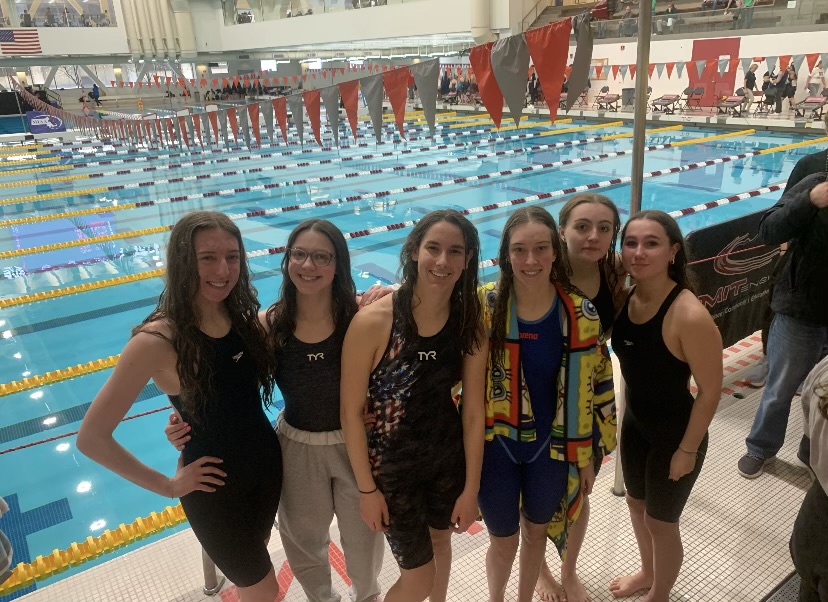Why High School Athletes Move On To Becoming College Athletes… Or Not
Navigating one’s way to a college team can be a complicated process for high school athletes.
The 2023 Ludlow High School Girls Swim Team (L-R): Abigayle Goncalves-Korny, Kaitlyn Lafond, Faith Keroack, Amanda Riley, Mia Bulatewicz, and Aleksa Kochanek.
June 1, 2023
The buzzer went off for my last race at the State Championship meet, the nerves built up, and all that was left to do was live in the moment. As I stood at the edge of the pool, looking down at the lane lines, the adrenaline rush was like no other, and it was at that moment that I realized I wanted to swim at the college level.
You may think of the connections the athletes will make or moving on to becoming professional athletes, but, sports are used as a distraction to balance academics and athletics. Being a part of a college sports team is a spot that is earned—there are eligibility requirements for participation by a student-athlete. Academic wishes impact athletic decisions, too.
As the Athletic Director, Mr. Brillo, here at Ludlow High School, says, “I think it is the connections you make. It helps you with time management in school; it’s just the experience of being a part of something bigger than yourself that is awesome.”
Simply understanding that the benefits of the lessons college sports can teach you in life are endless.
It is important to know exactly what you are looking for—things such as sports division, recruiting process, scholarship possibilities, and coaches impact a student athlete’s decision to put their athletic career into the hands of a coach or a school.
Former High School Athlete: Aaron Turgeon
So, how do athletes make the ultimate decision to become a college athlete? A former LHS student-athlete, Aaron Turgeon, wrapped up his first year of college swimming for a division III swim team, attending Keene State.
He can say that “Just by swimming, I have learned my own limitations and how to push them as well as how to push others to be their best selves they can be.”
It was important for him to find a school that had what he wanted academically while also being able to swim, as he did every year of his high school career. He adds, “When it came to deciding who I was going to swim for I wanted a team that was supportive and would push me, but I also wanted a team that has a flexible schedule so I can have the best of both worlds in academics and athletics.”
He heavily admires the benefits of being a college athlete, saying that “you will learn a lot about yourself and you will learn from the people you meet.”

Recruiting Process: Different Types
On that account, there are three different types of recruiting processes: walk-ons, tryouts, and recruits.
Walk-on—or unrecruited—consists of the athlete who is accepted into the school on their own, and finds a way to join the team through an open tryout. It is important to communicate with the coach early, and show your interest in the team, and doing so also helps the athlete get to know the coach and decide if the team is right.
Walk-ons are much less common, as most athletes are in communication with the coach prior to joining the team. Typically, the NCAA Division II and Division III schools welcome walk-ons.
A tryout is generally when a student-athlete qualifies for acceptance to the school and to the sport—tryouts allow the coach to test the athlete’s strength and sports skills. After the examination, the coach decides whether the athlete is suitable for the team.
Recruiting is when the coach gathers an idea of prospective athletes, then sends out letters of recruitments, personalized camp invites with the team, emails from coaching staff, verbal offers, etc.
Turgeon was recruited by the swim coach at Keene State; and, it showed him that the coach was interested in his success in the pool.
Graduating Student-Athlete in the Class of 2023: Jadyn Neiford
Another former LHS student-athlete—a swimmer—Jadyn Neiford, was recruited to many school’s; however, ultimately, she made the decision not to swim in college for specific reasons.
“I got recruited for other colleges like Westfield State, RIC, and Springfield College, and it would have been a lot more affordable for me,” she says. “However, these colleges weren’t as strong in my major of biotechnology.”
She ultimately made the decision to close the chapter of her life that included swimming: “I had to prioritize what would be my career in my future.” In the end, it was most important that Neiford found exactly what she was looking for academically and was proud to keep her swimming career in high school.
Both Tuegeon and Neiford chose to take on different wishes in college, as Turgeon decided to do a sport and Neiford decided what was best for her career. Each and every high school athlete is different; therefore, everyone may have a different view of their goals for college and choose differently on what they want to make of their college years
Staff Perspective
Furthermore, Mrs. Lekarczyk—a guidance counselor at LHS—has helped many student athletes be successful in making a decision to participate in a college sport.
“Talented high school athletes may enhance their college application and open doors to scholarship opportunities,” she says. “Student athletes learn invaluable skills of teamwork, leadership, and effective communication skills, which will benefit them in life and the workforce.”
She connects the benefits of participating in a college sport to how they can influence the future lives of athletes.
On the other hand, Lekarczyk says, “For many students, I think balancing academics and athletics weighs heavily on their decision. As a collegiate athlete, the athletic schedule is very demanding, which doesn’t give them much free time to participate in leisurely activities.”
High school athletes are forced to make the ultimate decision, narrowing down what they truly want their college experience to be: continuing the sport at the collegiate level while pursuing their career or putting their all into their major and the future of their career. For some, like Neiford, they decide it is best to leave the athletic chapter of their lives behind.
It is clear that each student should weigh all options of what they want their college experience to be. For some, that may be academics and athletics or just academics. The choices that are made by students are powerful and everlasting decisions that will shape each individual for the future.


